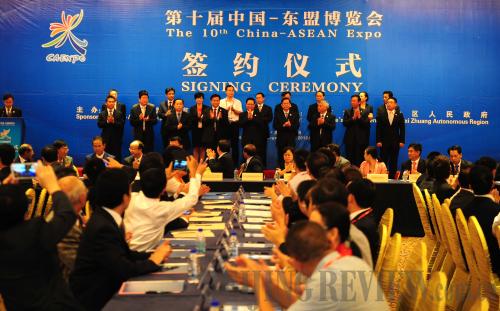|
 |
|
DONE DEALS: At the signing ceremony of the 10th China-ASEAN Expo held on September 4, 73 international projects worth $8.6 billion and 94 domestic projects worth of 68.1 billion yuan ($11.13 billion) were signed (HUANG XIAOBANG) |
For China, ASEAN is already its third largest trading partner and trade with the region is in the fast lane. In the first seven months of 2013, trade between China and ASEAN totaled $247.72 billion, an increase of 12.4 percent. In sharp contrast, trade between China and its largest trade partner EU declined 1.8 percent during the period and trade between China and its second largest partner, the United States, increased 6.2 percent, according to figures from the Ministry of Commerce.
"If Premier Li's $1-trillion trade goal is achieved, ASEAN will be China's largest trade partner by 2020," said Xu. "The fact that China is willing to make that promise showcases its firm resolution and confidence in deepening cooperation with ASEAN." For ASEAN, cooperation with China is also of vital significance. "China has a lot to offer ASEAN, including experience in all kinds of infrastructure construction and industrial development," said Xu.
Ty Channa, Deputy Director of the Cambodian Agricultural Research and Development Institute, said ASEAN is counting on its ties with China to weather the global economic downturn. Datuk M. Supperamaniam, former Malaysian Representative to the WTO, said ASEAN's strategic partnership with China is demonstrated in economic, trade and investment ties. "What China and ASEAN have is not enough. There is so much more that needs to be done," he said.
"China and ASEAN are competitors. Nonetheless, they can still cooperate with each other as they can specialize in what they produce the best. It's extremely important to further expand investment fields, to strengthen cooperation in service trade, to remove any trade barriers that impede investment flows and to improve trade logistics."
Upgrade ties, how?
Premier Li expressed China's willingness to expand the content and scope of the China-ASEAN free trade area. Li also said China is willing to join hands with ASEAN to advance talks of a Regional Comprehensive Economic Partnership (RCEP).
The RCEP is an ASEAN-led trade agreement linking the economies of 16 Asia-Pacific countries. It aims to be the largest free trade bloc in the world, comprising all 10 ASEAN nations and the six other countries with which the group has free trade agreements—China, India, Japan, South Korea, Australia, and New Zealand. The grouping includes more than 3 billion people, has a combined GDP of about $17 trillion, and accounts for about 40 percent of world trade. Negotiations began in early 2013 and are expected to conclude by the end of 2015. This year, Australia attended the 10th China-ASEAN Expo as an observer country.
As for China and ASEAN, they have great potential to renew and expand their agreements in key fields, such as hi-tech transfers and finance, analysts said at the expo. In September 2012, science and technology ministers from China and 10 ASEAN member states jointly launched the China-ASEAN Science and Technology Partnership Program and proposed the establishment of a center to facilitate such ties between the two sides. Such a center was inaugurated on September 3 during the 10th China-ASEAN Expo. The center is expected to ease policy coordination and create joint science and technology parks. "China and ASEAN have taken substantial steps to make technology transfer the next focal point for future economic cooperation," said Wan Gang, Chinese Minister of Science and Technology, during a forum on China-ASEAN Technology Transfer and Collaborative Innovation, a sideline of the 10th China-ASEAN Expo. Chae Sieng Hong, a senior official at the ministry of industry, mines and energy of Cambodia, said it would be a great step forward if China and ASEAN can solidify their ties in the area of science and technology.
|
